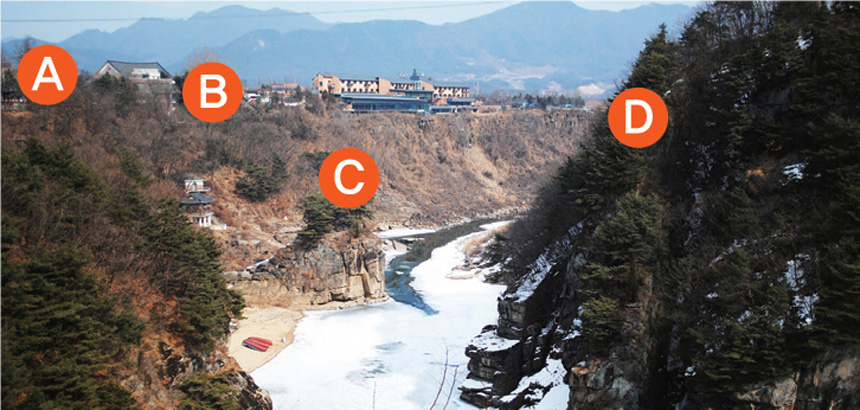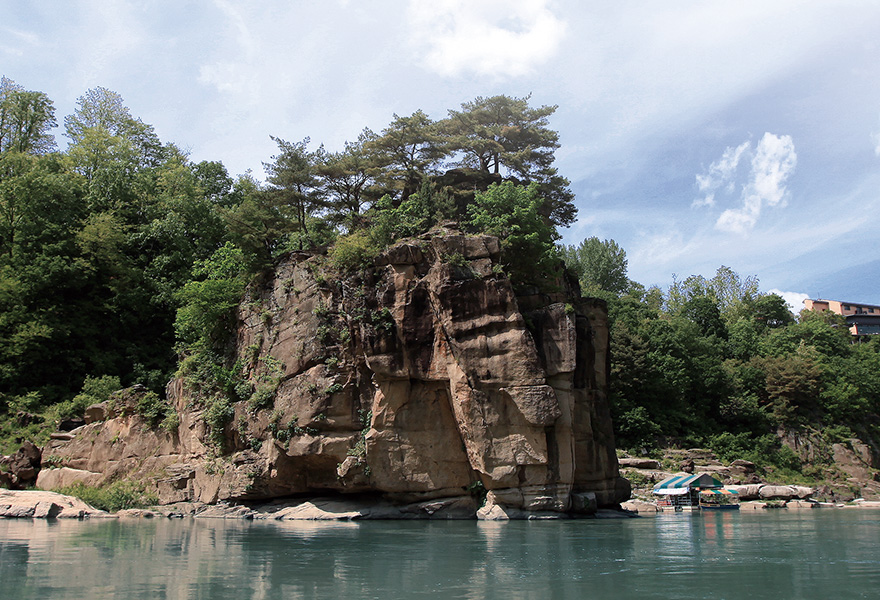Representative
Geosite
Representative
Geosite
Goseokjeong
- Samtong(Gush-Out Water)
- Soisan Mountain(Cheorwon Lava Land)
- Jiktang Waterfall
- Goseokjeong
- Sambuyeon Falls
- Hwajeogyeon
- Mt. Jijang tuff
- Bidulginang Falls and Meonguri canyon
- Pocheon Auraji pillow lava
- Art Valley and Pocheonseok
- Jaein Falls
- Baekuiri Layer
- Jwasangbowi Rock
- Eundaeri Planticular Joint and Fold Structure
- Jeongokri ruins soil stratum
What kind of rock is "Goseok" made of?
Goseok is a 15-meter-high granite observed inside the Hantan River Gorge in Jangheung-ri, Dongsong-eup, Cheorwon-gun. Since there is a pavilion called Goseokjeong located nearby, the area around the Valley is also named as Goseokjeong. Along with the topography before the formation of the basalt lava plateau, this area has a high geological and topographical value, since it let people know the fact that the basal lava flowed over the bed rock, forming a lava plateau. The Goseok is a granite that was formed about 110 million years ago (mid Cretaceous period) before Cheorwon was covered with lava. This is the result of volcanic activity that occurred between 540,000 and 120,000 years ago, Due to this volcanic eruption, basalt lava covered the Goseok, but then it re-emerged on the surface because of the erosion caused while Hantan river was forming a new waterway.
Why has the rock which was buried in the lava plateau exposed to the ground?
Hantan River, which has the Goseok, flows between the lava fields of Cheorwon creating a deep gorge. However, the water of the Hantan River before the eruption was different from today. The birth of the current valley was caused by the filling of the existing water path and the rise of the river beds height, which made the river cut down the bottom more fiercely(lower erosion power), after the formation of the lava plateau. This is because streams have a basic tendency to adjust their height to the sea level. This is an inevitable phenomenon in the formation of lava fields. This caused the Hantan River to dig deep into the lava fields, and in the process, the Goseok that was part of the bed rock(granite) that was covered with basalt lava was exposed to the ground.
Which is Granite and which is Basalt?
If you look at the terrain of this area around the Goseok, both sides are asymmetrical. This is due to the active erosion along the interface(boundary) of the two rocks, mainly in the process of the newly formed Hantan River. As this case, erosion tends to occur more easily, turning into a deep valley over time. Due to this effect, the Goseok area where the granite was located, forms a gentle hill, but the side where the basalt was located forms a vertical cliff because of the columner joint, and the asymmetrical terrain on both sides of the stream could be clearly observed.
Additionally, the Goseok is the most representative place, which is able to be observed within the Hantan River valley, where granite, the bed rock, is covered by unconformity due to the basalt.
 The Contrasting View of the Hantan River Valley
The Contrasting View of the Hantan River Valley
 Geographical section near the Goseok
Part A is flat lava field, and its thickness ranges from several meters to tens of meters. In part B, the basalt columnar joints, which compose the lava fields, form a vertical steep slope.
Geographical section near the Goseok
Part A is flat lava field, and its thickness ranges from several meters to tens of meters. In part B, the basalt columnar joints, which compose the lava fields, form a vertical steep slope.art C is exposed to granite-based rock 'Goseok' in the middle of the stream, and part D is a granite layer identical to that of the Goseok, showing a relatively gentle slope compared to the basalt layer.
[Source: Kim Joo-hwan (1997)
